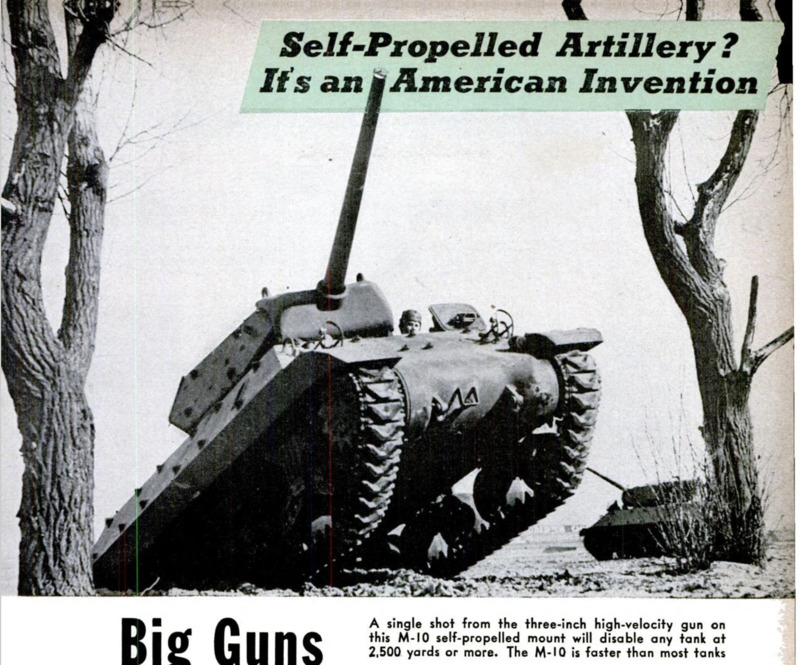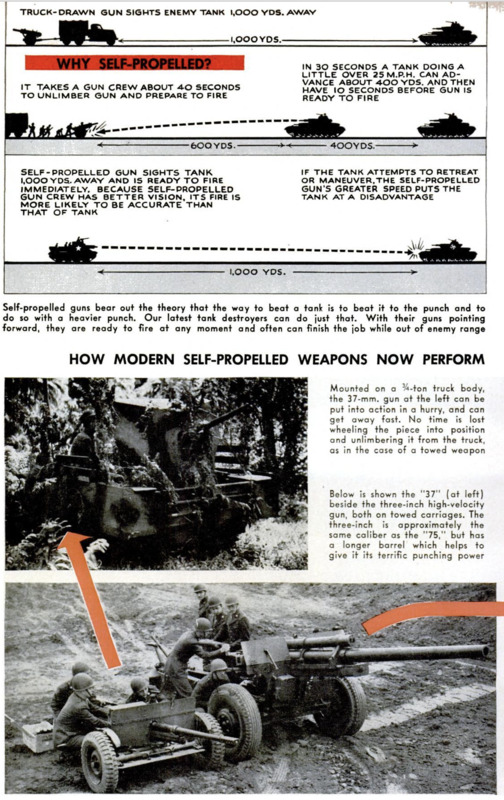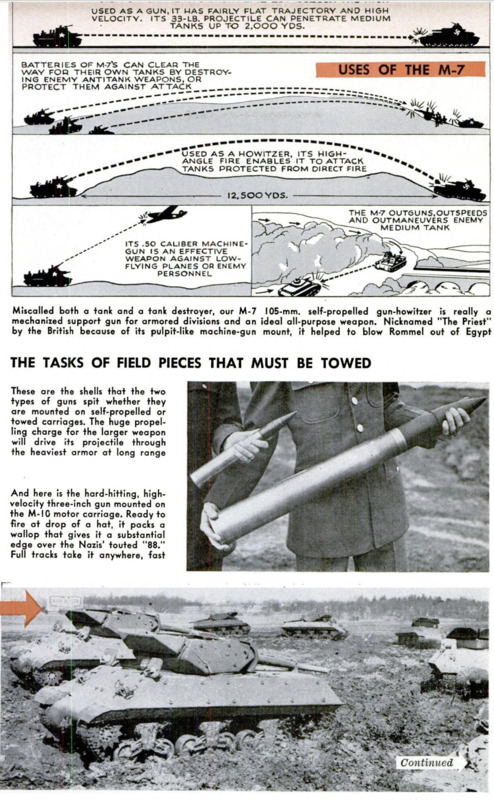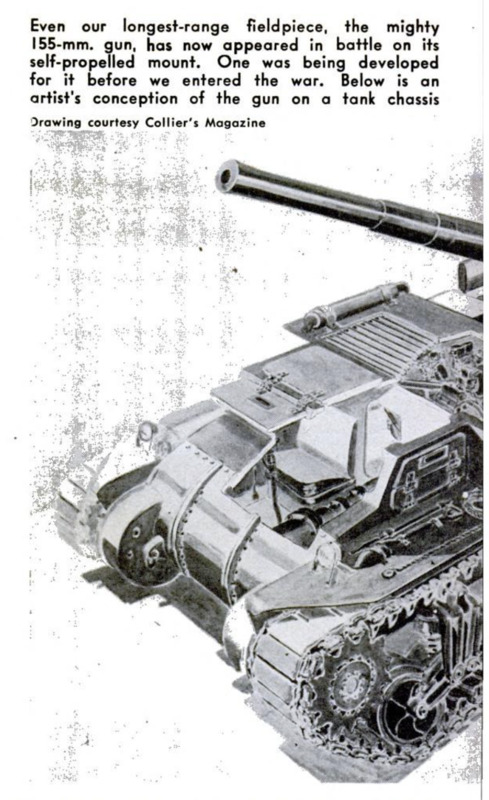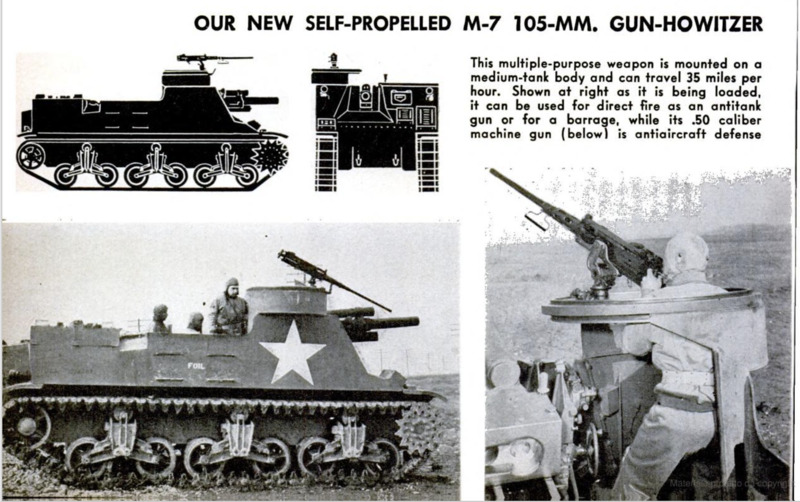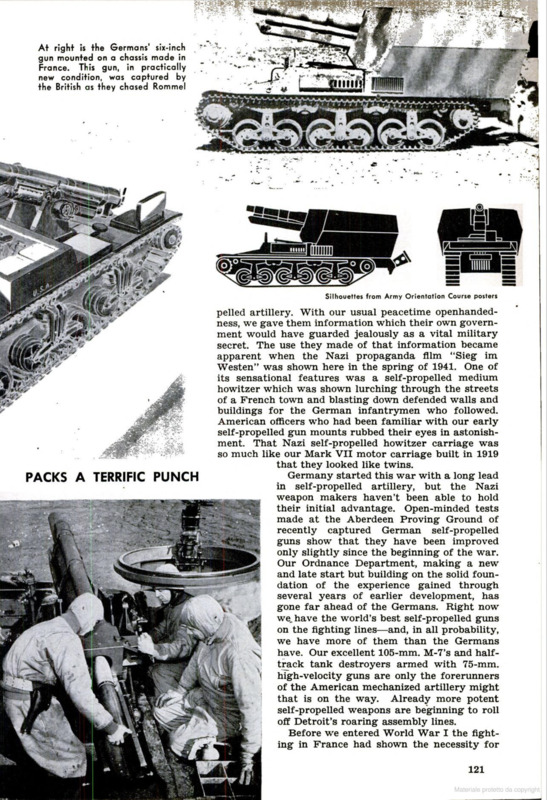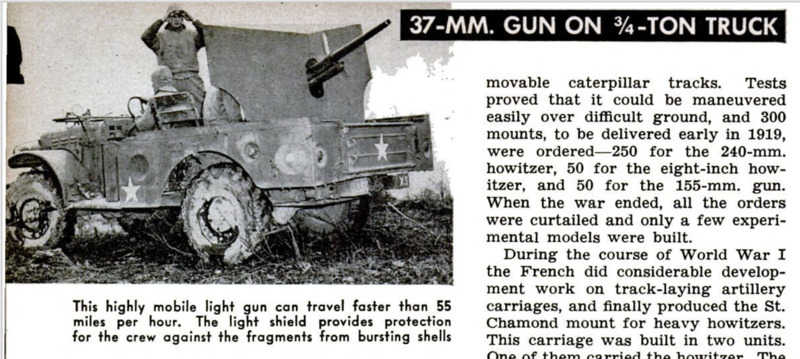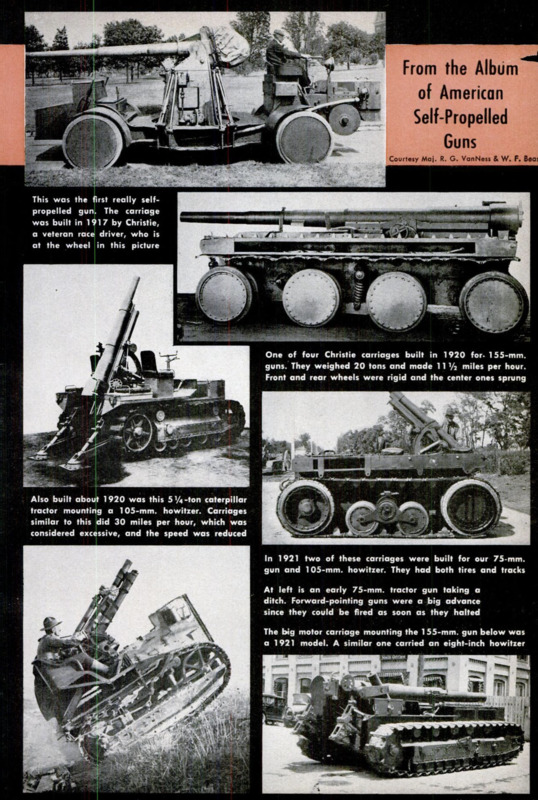-
Title (Dublin Core)
-
Big Guns That Stalk Their Targets
-
Article Title and/or Image Caption (Dublin Core)
-
Big Guns That Stalk Their Targets. U. S. Ordnance Engineers Taught the German How to Put Cannon on Mechanized Mounts...and Now We're Beating Them at Building these "Surprise" Weapons
-
extracted text (Extract Text)
-
OUR self-propelled artillery, first spot-
lighted by the outstanding perform-
ance of our mechanized 105-millimeter gun-
howitzers on their initial appearance in the
fighting on the North African desert, is go-
ing to play an increasingly important part
in the winning of the war.
Many Americans who read of how our
M-T's, lend-leased to the British Eighth
Army, blasted Rommel's Afrika Korps tanks
into fire-blackened hulks in the Battle of El
Alamein thought back to the early days of
the current struggle, remembered that the
Nazis had used self-propelled guns effective-
ly in their Polish, French, and Balkan cam-
paigns, and took it for granted that mount-
ing cannon on self-propelled carriages in-
stead of hauling them behind horses, trucks,
or tractors was a German innovation which
we successfully copied.
But self-propelled artillery most emphati-
cally is not a German innovation. It was
pioneered by the U. S. Army over a quarter
century ago.
Our Army Ordnance Department built the
world's first self-propelled gun. During
World War I it built a considerable number
in various calibers.
After that war it continued the develop-
ment with such success that In 1920 the
Westervelt Board of experts appointed to
redesign all our Army artillery weapons
reported that it had eight models of self-
propelled guns of from 75-mm. to 156-mm.
caliber under test or under production, and
that in weapons of this type our Army was
far in advance of all the others in the world.
‘Then, in the early 1930's, we threw away
the invaluable lead which had been won by
the inventiveness, ingenuity, and hard work
of our Ordnance officers and the civilian
automotive experts who had worked with
them. The principal cause was the niggard-
ly Congressional appropriations which made
further experimenting practically impos-
sible; between 1020 and 1033 the Army was
able to spend only $2,000,000 for experi-
‘mental work in all branches of mechaniza-
tion, including the development of the tank
But'a contributing factor was the belief held
by some high-ranking artillery officers that
the little money available would be better
spent on the improvement of our horse and
truck-drawn artillery than on the develop-
ment of the newfangled ~self-propelied
mounts which they thought would never
carry a gun onto a battlefield.
‘Some of the men who were busy rebulld-
ing the military machines of Europe were
better at seeing what was ahead. Especially
the Germans. In the 20's Germany had only
small army and smaller means of develop-
ing it, but the German military attachés
stationed in Washington evinced strong curi-
osity about our experiments with self-pro-
pelled artillery. With our usual peacetime openhanded-
ness, we gave them information which their own govern-
ment would have guarded jealously as a vital military
secret. The use they made of that information became
apparent when the Nazi propaganda film “Sieg im
Westen” was shown here in the spring of 1941. One of
its sensational features was a self-propelled medium
howitzer which was shown lurching through the streets
of a French town and blasting down defended walls and
buildings for the German infantrymen who followed.
American officers who had been familiar with our early
self-propelled gun mounts rubbed their eyes in astonish-
ment. That Nazi self-propelled howitzer carriage was
so much like our Mark VII motor carriage built in 1919
that they looked like twins.
Germany started this war with a long lead
in self-propelled artillery, but the Nazi
weapon makers haven't been able to hold
their initial advantage. Open-minded tests
made at the Aberdeen Proving Ground of
recently captured German self-propelled
guns show that they have been improved
only slightly since the beginning of the war.
Our Ordnance Department, making a new
and late start but building on the solid foun-
dation of the experience gained through
several years of earlier development, has
gone far ahead of the Germans. Right now
we have the world's best self-propelled guns
on the fighting lines—and, in all probability,
we have more of them than the Germans
have. Our excellent 105-mm. M-7's and half-
track tank destroyers armed with 75-mm.
high-velocity guns are only the forerunners
of the American mechanized artillery might
that is on the way. Already more potent
self-propelled weapons are beginning to roll
off Detroit's roaring assembly lines.
Before we entered World War I the fight-
ing in France had shown the necessity for
mobile antiaircraft guns, and in trying to
meet this need our Ordnance Department
mounted a 75-mm. gun capable of high-
angle fire on a White truck. This makeshift
was the first self-propelled gun of which
there is record. Shortly after we got into the
war, 200 of them were built. A few were
used in France, and some were kept in
service until only a few years ago.
In 1917 our Ordnance officers, assisted by
J. Walter Christie, former race driver and
pioneering automotive engineer, produced
the world's first real self-propelled gun—a
three-inch antiaircraft gun mounted on a
low-slung, four-wheeled carriage propelled
by a gasoline engine. Caterpillar tracks
soon replaced the wheels, and the mount
proved highly satisfactory.
Shortly after we entered the last war,
work was started on a self-propelled mount
for heavy guns. In 1918 the Christie motor
carriage for the eight-inch howitzer was
produced, many Holt caterpillar tractor
parts being used in its construction. It
weighed 17 tons, and a 120-horsepower gaso-
line engine gave it a top speed of 16 miles
per hour. It had rubber-tired wheels, the
center ones independently sprung, and re-
movable caterpillar tracks. Tests
proved that it could be maneuvered
easily over difficult ground, and 300
mounts, to be delivered early in 1919,
were ordered—250 for the 240-mm.
howitzer, 50 for the eight-inch how-
itzer, and 50 for the 155-mm. gun.
When the war ended, all the orders
were curtailed and only a few experi-
mental models were built.
During the course of World War I
the French did considerable develop-
ment work on track-laying artillery
carriages, and finally produced the St.
Chamond mount for heavy howitzers.
This carriage was built in two units.
One of them carried the howitzer. The
other, a limber, carried the gasoline-engine
power plant and ammunition. The limber
could be driven into cover while the gun
was in action. The St. Chamond didn't get
far beyond the experimental stage. The
British built 50 tanks designed to carry six-
inch howitzers which could be fired from the
tank or, with more accuracy, from the
ground. They were not successful. The
British did not build any real self-propelled
guns. There is no record of the Germans
having even experimented with self-pro-
pelled artillery.
After the war, our automotive-minded
Ordnance officers continued their efforts to
produce satisfactory self-propelled gun
mounts under the direction of Col. Lucien
B. Moody. Among the workers were Maj.
Gen. Levin H. Campbell, Jr. the present
Chief of Ordnance, and Brig. Gen. Gladeon
M. Barnes, now in charge of ordnance de-
velopment, who then were captains, and
Cols. B. C. Lewis, W. A. Capron, and H. W.
Alden. Among the civilian engineers who
did valuable work were Carl Bock, now
chief engineer of the General Motors Truck
Company, and W. F. Beasley and D. A.
Gourney, both still
connected with the Ordnance Department,
The late Plinty Holt, inventor of the cater-
pillar tractor, and Christie were active both
in designing and manufacturing mounts.
In 1920 two Ordnance-designed Mark VII
motor carriages were built by the Holt Trac-
tor Company, one for thie 75-mm, gun and
the other for the three-inch gun and the
105-mm. howitzer. These carriages were the
first to carry the gun with its muzzle point-
ing forward—one of the big advantages of
modern self-propelled mounts. Their weight
was under six tons and their V-8 72-horse-
power engines gave them a speed of 30 miles
per hour, which was considered so much too
fast that it was reduced by two thirds. They
could climb a 35-degree slope and cross a
34-inch-deep stream, and they burned only
half a gallon of gasoline per mile. Rubber
blocks were used to absorb shocks. The gun
crews were protected by removable front
and side shields. Men who worked on the
Mark VII's say that they would be rated
good self-propelled guns even by present-
day standards and that the Germans made
no mistake when they modeled their 105-mm.
self-propelled howitzer after them.
‘The Christie motor carriage for the 155-mm.
G. P. F. gun also was produced in 1920.
It weighed 20 tons, and its speed was 15
miles per hour. Like most Christie combat
vehicles, it used both wheels and tracks.
Adjusting the removable tracks over the
wheels was a half-hour job. Six 33-ton
track-laying mounts for the 155-mm. gun or
eight-inch howitzer were built and service-
tested shortly afterward. The following year
two Christie carriages for the 75-mm. gun
or 106-mm. howitzer were built. They
weighed about eight tons and had a top
speed of 20 miles per hour.
Then for several years meager appropria-
tions restricted development to the rebuild-
ing and improving of existing models. In
1928 a mortar mount was built on the
chassis of a T-1E1 tank. Two years later
the T-1 motor carriage for the 75-mm. pack
howitzer was produced. It weighed six tons
and could do 21 miles per hour.
The T-1 was the last self-propelled gun
built in America until the Nazi blitzkriegs in
Europe showed how essential these weapons
were in mechanized warfare. Until they
were broken up for scrap metal, the old
mounts were preserved as curiosities or al-
lowed to rust on scrap heaps at the arsenals.
But that effort and money wasn't wasted.
Since the M-7 made its sensational initial
appearance at El Alamein, much has been
written about the fact that its production
layouts were drafted in 16 days and that
three weeks ater the blueprints were com-
pleted the first models were being tested.
That would not have been possible without
the know-how acquired by our Ordnance
Department during its decade of pioneering.
Meanwhile, the Germans were emphasiz-
ing the importance of self-propelled guns
pointing in the direction of the march, but
in spite of these views published widely in
Germany as early as 1936, actual use of this
type of weapon came as a surprise. Most
important of the Nazi self-propelled guns
are the 75-mm. assault gun, 105-mm.
howitzer, 105-mm. gun, and 150-mm. gun.
One captured by the British is a 150-mm.
howitzer on the chassis of a French Renault
light tank.
Our real start came two years ago with
the realization by Brig. Gen. Andrew D.
Bruce, then a lieutenant colonel on the
General Staff, that the best way to beat
tanks is with quick-acting, high-velocity
guns. It would take even the smartest crew,
he reasoned, about 40 seconds to unlimber
its gun from a truck, swing it around, and
fire. In that time a tank could approach
within range, stop, and still have 10 seconds
to fire several carefully aimed shots. What
we needed were guns that would always be
pointing the right way and could be fired
the moment an enemy tank was sighted.
Bruce was put in command of an experi-
mental tank-destroyer battalion, and the
Ordnance Department made up for lack of
self-propelled guns by combining standard
guns with standard vehicles. It delivered
over 50 in two months. Our 75-mm. high-
velocity tank gun mounted on a T-14
armored half-track scout car produced the
M-3 motor carriage with a road speed of
50 miles per hour. It points forward, is
mounted so the driver can remain in his
seat when it is fired, and throws a projectile
that will penetrate most tanks at 1,000
yards. Its three-man gun crew is protected
by armor and a .50 caliber antiaircraft
‘machine gun.
Lighter destroyers were made by mount-
ing 37-mm. guns on jeeps and T-8 motor
carriages (swamp buggies). Later the 37
was put on Fargo 3/4 -ton trucks.
Tested in maneuvers in the fall of 1941,
the battalion was so successful that more
were organized and a Tank Destroyer Com-
mand was formed with Bruce, promoted to
brigadier general, at its head. Lieut. Gen.
Lesley J. McNair, chief of the Army Ground
Forces, gave Bruce full credit, remarking
that seldom has one man both the vision to
conceive such a project and the ability to
carry it through to full bloom.
The motto of the tank-destroyer units is
“Seek—Strike—Destroy.” They have but
one mission, destruction of enemy tanks.
Superior speed enables them to beat the
enemy to positions of ambush, and superior
guns enable them to make the kill.
Our new three-inch antitank gun, only
1/20 inch larger in caliber than the 75, has
a longer barrel and uses a much heavier
charge. A single solid hit will disable any
known enemy tank up to—and probably weil
over—2,500 yards. Still another anti-tank
gun is smaller than the 75, but has greater
armor-piercing power.
Nicknamed “The Priest” by the British
because of the altar-like appearance of its
machine-gun mount, the new 105-mm. self-
propelled gun-howitzer is an eight-foot-long,
1,200-pound, mechanized support gun for
armored divisions. It is an ideal all-purpose
weapon. Used as a gun, it has a fairly high
velocity and a fairly flat trajectory, and its
33-pound, 4.1-inch-diameter projectile will
penetrate medium-tank armor at 2,000 yards.
As a howitzer, it has an extreme range of
over seven miles, throwing high-explosive
shells at a high angle to destroy emplace-
ments protected from direct fire. Its speed
of over 35 miles an hour enables it to keep
up with fast tanks on the march and to
outmaneuver German medium tanks.
brigadier general, at its head. Lieut. Gen.
Lesley J. McNair, chief of the Army Ground
Forces, gave Bruce full credit, remarking
that seldom has one man both the vision to
conceive such a project and the ability to
carry it through to full bloom.
The motto of the tank-destroyer units is
“Seek—Strike—Destroy.” They have but
one mission, destruction of enemy tanks.
Superior speed enables them to beat the
enemy to positions of ambush, and superior
guns enable them to make the kill.
Our new three-inch antitank gun, only
1/20 inch larger in caliber than the 75, has
a longer barrel and uses a much heavier
charge. A single solid hit will disable any
known enemy tank up to—and probably weil
over—2,500 yards. Still another anti-tank
gun is smaller than the 75, but has greater
armor-piercing power.
Nicknamed “The Priest” by the British
because of the altar-like appearance of its
machine-gun mount, the new 105-mm. self-
propelled gun-howitzer is an eight-foot-long,
1,200-pound, mechanized support gun for
armored divisions. It is an ideal all-purpose
weapon. Used as a gun, it has a fairly high
velocity and a fairly flat trajectory, and its
33-pound, 4.1-inch-diameter projectile will
penetrate medium-tank armor at 2,000 yards.
As a howitzer, it has an extreme range of
over seven miles, throwing high-explosive
shells at a high angle to destroy emplace-
ments protected from direct fire. Its speed
of over 35 miles an hour enables it to keep
up with fast tanks on the march and to
outmaneuver German medium tanks.
Even newer is the M-10 tank-destroyer
mount (P.S.M., May '43, p. 72), already
Dattle-tested in North Africa and now being
produced in quantity. Although the M-10
is a full-tracked vehicle with heavy welded
armor plate, it is faster than most tanks, and
its high speed and low silhouette make it a
difficult target. It carries a gun that is
larger than the 75, packs a mighty wallop,
and is more than a match for the German
88-mm. converted antiaircraft gun.
Newest and biggest of all is the M-12
motor gun carriage, which mounts our 155-
mm. gun. Utilizing the chassis of an M-3
tank, this highly mobile weapon can throw
a 95-pound projectile more than 10 miles
and could knock out the biggest tank or
even sink a heavy cruiser at that distance.
This juggernaut on tracks is especially ef-
fective against enemy artillery and forti-
fications and can work in any terrain suit-
able for operations of medium tanks.
-
Contributor (Dublin Core)
-
Arthur Grahame (writer)
-
Language (Dublin Core)
-
eng
-
Date Issued (Dublin Core)
-
1943-07
-
pages (Bibliographic Ontology)
-
117-123, 207, 208, 210
-
Rights (Dublin Core)
-
Public Domain (Google digitized)
-
Archived by (Dublin Core)
-
Matteo Ridolfi
-
Alberto Bordignon (Supervisor)
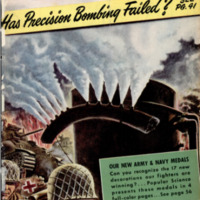 Popular Science Monthly, v. 143, n. 1, 1943
Popular Science Monthly, v. 143, n. 1, 1943

